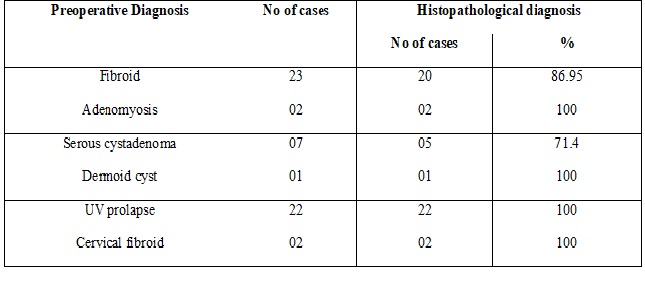Clinicopathological Analysis of Hysterectomy Specimens
Abstract
Introduction: The uterus is vital reproductive organ prone to develop several non-neoplastic and neoplastic lesions in womancontributing significantly to increased morbidity and mortality. Although many treatment options are available, hysterectomy isstill widely used treatment modality worldwide.
Objectives: The study was proposed to analyse the patterns of lesions in hysterectomy specimens and to analyse the clinico-pathological correlation in hysterectomy specimen.
Methods: A 6-monthretrospective study was performed in Department of Pathology, Karwar institute of Medicalscience, Karwar. Baseline data were collected from inpatient files and histopathology reports were collected from Department of Pathology,to identify the most common pathologies in hysterectomy specimens.
Results:78 hysterectomy cases were analysed and the peak age group were from 35-45 years (42.30%), and the most common clinical presentation was fibroids (42.30%). Most common histopathological lesion was leiomyoma 37 cases (47.4%), followed by 16 cases (12.82%) presented as adenomyosis, and 14 cases (10.26%) had dual pathology of both leiomyoma and adenomyosis. The commonest incidental histopathological finding seen in hysterectomy specimens was chronic cervicitis.
Conclusions: Hysterectomy is the most commonly performed elective major gynaecological surgery. Though the histopathological analysis correlates well with the clinical diagnoses, quite a few lesions like chronic cervicitis and adenomyosis were encountered as pure incidental findings. Hence, it is mandatory that every hysterectomy specimen, even if it grossly appears to be normal, should be subjected to detailed histopathological examination for confirming diagnosis and better postoperative management
Downloads
References
2. Krentel H, Wilde RLD. Laparoscopic supracervical hysterectomy with in-bag morcellation in very large uterus. Case reports in medicine. 2017;2017.
3. Donnez O, Jadoul P, Squifflet J, et al. A series of 3190 laparoscopic hysterectomies for benign disease from 1990 to 2006: evaluation of complications compared with vaginal and abdominal procedures. BJOG. 2009 Mar;116(4):492-500. doi: 10.1111/j.1471-0528.2008.01966.x. Epub 2008 Nov 11.[pubmed]
4. Sreedhar VV, Jyothi C, Sailaja V, Paul MC, Sireesha O, Vani T, et al. Histopathological Spectrum of Lesions of Hysterectomy Specimens–A Study of 200 Cases. Saudi J Pathol & Microbiol. 2016;1(2):54-9.
5. Jaleel R, Khan A, Soomro N. Clinicopathological study of abdominal hysterectomies. Pak J Med Sci. 2009;25(4):630-34.
6. Thompson JD. Hysterectomy. In: Thompson JD RJ, eds. Te Linde’s Operative Gynecology. 7th edition. JB Lippincott Company, Philadelphia, 1992. 663-738.
7. MacKenzie IZ, Naish C, Rees M, Manek S. 1170 consecutive hysterectomies: indications and pathology. British Menopause Society Journal. 2004;10(3):108-12.[pubmed]
8. Sachin AK, Mettler L, Jonat W. Operative spectrum of hysterectomy in a German university hospital. Journal of obstetrics and gynecology of India. 2006;56(1):59-63.
9. Pandey D, Sehgal K, Saxena A, Hebbar S, Nambiar J, Bhat RG. An audit of indications, complications, and justification of hysterectomies at a teaching hospital in India. International journal of reproductive medicine. 2014;2014.
10. Mukhopadhaya N1, Manyonda IT. The hysterectomy story in the United Kingdom. J Midlife Health. 2013 Jan;4(1):40-1. doi: 10.4103/0976-7800.109635.[pubmed]
11.Verma D, Singh P, Kulshrestha R. Analysis of histopathological examination of the hysterectomy specimens in a North Indian teaching institute. Int J Res Med Sci. 2016;4(11):4753-8.
12. Adelusola K, Ogunniyi SO. Hysterectomies in Nigerians: histopathological analysis of cases seen in Ile-Ife. The Nigerian postgraduate medical journal. 2001;8(1):37-40.
13. Sarfraz T, Tariq H. Histopathological finding in menorrhagia. A study of 100 hysterectomy specimens. Pak J Pathol. 2005;16(3):83-5.
14. Broder MS, Kanouse DE, Mittman BS, et al. The appropriateness of recommendations for hysterectomy. Obstet Gynecol. 2000 Feb;95(2):199-205.[pubmed]
15. Shaikh TA, Memon F, Memon Z. Hysterectomies; an audit at a tertiary care hospital. Professional Medical Journal. 2011;18(1).
16. Butt JL, Jeffery ST, Van der Spuy ZM. An audit of indications and complications associated with elective hysterectomy at a public service hospital in South Africa. Int J Gynaecol Obstet. 2012 Feb;116(2):112-6. doi: 10.1016/j.ijgo.2011.09.026. Epub 2011 Dec 3.[pubmed]
17. Toma A, Hopman WM, Gorwill RH. Hysterectomy at a Canadian tertiary care facility: results of a one year retrospective review. BMC Womens Health. 2004 Nov 23;4(1):10. DOI:10.1186/1472-6874-4-10
18.Talukder S, Haque M, Huq M, Alam M, Roushan A, Noor Z, et al. Histopathological analysis of hysterectomy specimens. Mymensingh medical journal: MMJ. 2007;16(1):81-4.
19. Jamal S, Baqai S. A clinicohistopathological analysis of 260 Hysterectomies. Pak J Pathol. 2001;12(2):11-4.
20. Shergill SK, Shergill HK, Gupta M, Kaur S. Clinicopathological study of hysterectomies. Journal of the Indian Medical Association. 2002;100(4):238-9, 46.
21. Weiss G, Maseelall P, Schott LL, et al. Adenomyosis a variant, not a disease? Evidence from hysterectomized menopausal women in the Study of Women's Health Across the Nation (SWAN). Fertil Steril. 2009 Jan;91(1):201-6. doi: 10.1016/j.fertnstert.2007.11.025. Epub 2008 Feb 20.[pubmed]
22.Tiwana KK, Nibhoria S, Monga T, Phutela R. Histopathological audit of 373 nononcological hysterectomies in a teaching hospital. Pathology research international. 2014;2014.
23. Perveen S, Tayyab S. A clinicopathological review of elective abdominal hysterectomy. Journal of Surgery Pakistan (International). 2008;13(1):27.
24. Nausheen F, Iqbal J, Bhatti FA, Khan AT, Sheikh S. Hysterectomy: The patients perspective. Annals of King Edward Medical University. 2004;10(4)



 OAI - Open Archives Initiative
OAI - Open Archives Initiative


